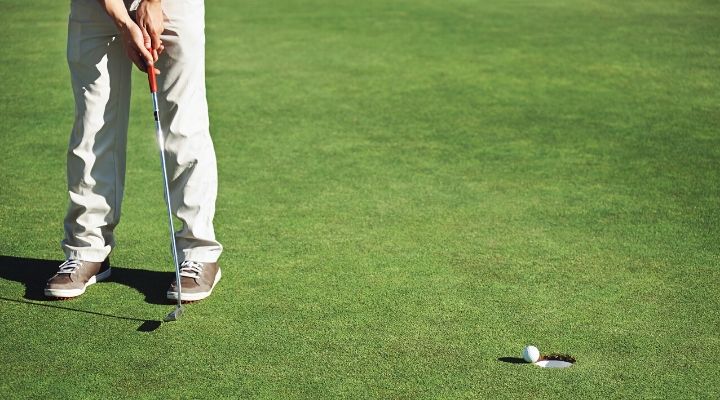How to Putt in Golf? Putting in golf is a simple stroke to master, but it’s crucial to perform it on the right playing surface. The putting green provides the perfect playing surface to practice your putting. The ultimate goal of the putt is to get the ball into the hole. Here are a few tips for putting. Practice on a putting green before you start playing the game. It will help you achieve your goal!
How to Putt in Golf – Techniques
There are many techniques to help improve your putting in golf. You can improve your game by practicing the proper grip on your putter. It is also important to keep your hands together and make sure the palms face each other while gripping the golf club shaft. Make sure that the back of your left hand is pointing in the direction where you want the ball to roll. Holding your position when putting will help you check that your alignment is correct.
When putting, it is important to remember that you should maintain a light grip pressure on the club handle. You will only be swinging the club for a short distance, and you don’t want to overstretch your fingers. Instead, let the putter hang naturally in your hands. Your body will control the stroke, which will result in better putt results. This technique will also result in lower scores.
Another important technique is modifying your putting stroke. If you are a big fan of the curving putt, then you must modify your putting stroke. If you are a big fan of the fringe putt, you must imagine the hole to be farther away, so that you don’t miss the hole entirely. It is important to follow through with the ball, otherwise, it is difficult to score par. Adapting to different putting situations is vital to lowering your scores.
Line
When aiming for a line putt in golf, focus on the orientation of the green between the ball and hole. Crouch down halfway along the line. You should envision an equilateral triangle with the ball on one side and the hole on the other. This will help you draw a clear visual of the line on the green. Imagine it being drawn by a giant colouring pencil. Then, move your body in that direction when you aim for the line.
While some golfers don’t use a line, many do. A line helps to remove any doubt as to whether the ball/putter is aimed at the intended spot at address. It also frees up the stroke and helps the player connect to the target. A line also helps the player make subtle adjustments at address, making the stroke more focused. Most professional and collegiate players use a line to guide them on short putts, but do not use one on longer putts with significant break.
Many golfers find it easier to read a line putt when they focus on the ball’s entry point. However, some golfers have trouble seeing a line and end up under-reading their putts. For this reason, focusing on a small target before attempting a putt may be the better option. While practicing, consider the pros and cons of each technique. When trying to improve your game, always remember that there’s no perfect way to putt.
Speed
There is no one exact formula for speed when putting in golf, but there are some general guidelines to follow to increase speed. The first thing to remember is that you cannot feel or see speed; therefore, any formula will have a certain margin of error. Also, golfers are not math nerds. That is why they cannot physically feel, smell, or see speed. Instead, they can only feel and gauge how far their putt travels from the starting point.
When putting in golf, the optimal putt speed is about 40 to 60 mph, while excess speed reduces the size of the hole. Aiming for the perfect speed depends on the distance between the ball and the hole, and the type of putter you have. Putting from longer distances, however, requires great skill and control. It is important to read the green correctly, but speed determines how quickly you can make a good read.
When practicing putting in golf, you should experiment with different speeds and distances to find out which works best for you. It is also important to practice on the same green and conditions. Aiming for a speed of about 17 inches is ideal for improving your game. Moreover, the speed and direction of your putts should match the speed of the hole. However, remember that speed does not necessarily mean accuracy. So, practice often and learn the techniques that work for you.
Keeping your head still
One tip for putting in golf is to keep your head still while putting. Keeping your head motionless will allow you to keep your shoulders in line and hit your putts straighter. Practice using the “dime drill” to help you focus on the ball and avoid making errors. Here’s a drill that will help you keep your head as still as possible while you putt. If you are not sure how to do this drill, here are some tips:
During the putting motion, keep your head still. This tip is almost impossible to practice, but you should still try to practice it as much as possible. This tip is especially useful if you are hitting shots off the tee or turf. In addition, you’ll have better accuracy in your short and long shots. Keeping your head still will also help you improve your putting stroke, which will make it easier for you to make more consistent attempts.
In addition to keeping your head still, you should also try to keep your shoulders and wrists quiet when putting. This will help you to maintain a more consistent stance, which will help you to achieve consistent scores. Another tip for putting in golf is to practice with a mirror. Then, practice putting with a mirror to check if your head is tilting or not. You should do this when you’re practicing for a long time.
Avoiding sinking a putt
One of the best ways to avoid sinking a putt in golf is to focus on the line instead of the hole. After taking your address, you should forget about the hole and instead focus on the spot on the line where the ball will fall. Remember to set your clubface down the line first, instead of over the ball. This will allow you to swing it the way it should be, so that you don’t miss your putt.
Another great way to avoid sinking a putt is to maintain a good posture. Good posture is crucial for a successful shot. When standing in close proximity to the ball, you should extend your arms forward and draw your elbows into your rib cage. Then, bend over toward the ball and make sure that your putter head is behind the ball. Be careful not to stand too stiffly, as this can lock your movement.
The next tip for avoiding sinking a putt is to always look for water drains on the green. Using a visor or brim of a cap, you can check if the horizon is flat. If it isn’t, you can try curling your fingers around your face to block your peripheral vision. Another tip to avoid sinking a putt in golf is to push the ball gently towards the hole. If you hit it straight, you may end up putting the ball far off-course, resulting in a missed putt. A golfer should avoid pushing the ball too far away from the hole, as this will cause the ball to break.
Developing a consistent putting stroke
There are some key techniques for developing a consistent putting stroke in golf. One of them is minimizing lateral body movement and keeping the centre of pressure as even as possible. Amateurs showed greater sway and lost feel during impact. A golf club with a wide stance should minimize these movements. For a smooth putting stroke, a stance should be about three feet wide and the left elbow should be turned inward.
The proper setup and ball position are critical to an inside-outside stroke. Proper gripping and a consistent pace are vital in keeping the putter path square to the target line. A proper rhythm is also important in developing a consistent putting stroke. 99% of professional putters have a 3:1 ratio between their backswing and downswing. By keeping these fundamentals in mind, you can improve your putting stroke.
Confidence is a key factor in putting. Since most of golf is a mental game, a confident putter has the edge. A confident putter visualizes the ball going in the hole and eliminates negative thoughts. A deep breath, a roll of the rock, and a little practice on the golf course will make the difference. It’s not hard to improve your putting stroke, so don’t worry if you’re not already a pro.


